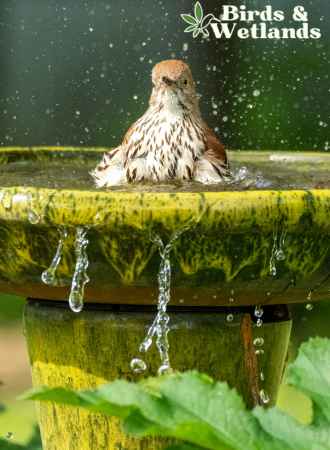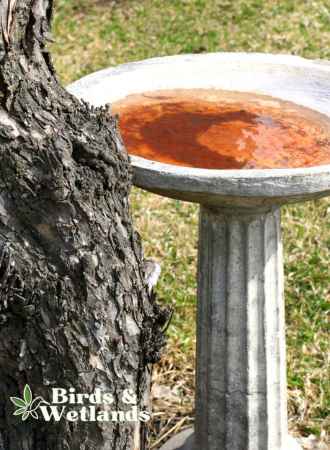As the weather gets warmer, birds become more active, and their visits to your backyard bird feeder and bird bath may increase.
While a bird bath can provide a refreshing drink and a place to splash around, it can also become a breeding ground for harmful bacteria and parasites if not properly maintained.
Key Takeaways on How to Clean Bird Baths
How to clean a bird bath

Keeping your bird bath clean is crucial for the health and safety of the your feathered friends that visit it. Over time, bird baths can accumulate algae, dirt, and other debris that can harm the birds.
Regularly cleaning your bird bath is a simple and easy process that can keep it looking great and keep the birds coming back for more.
Here is a step-by-step guide to cleaning a bird bath:
EMPTY
Remove the dirty water and deposits of spilled seed to see all the debris and dirt that may be stuck to the bottom of the bath.
BRUSH
Once the bird bath is empty, use a brush or a scraper to remove any debris, including leaves, twigs, and other organic matter stuck to the sides or bottom.
SCRUB
Use a scrub brush or a sponge to scrub the bird bath thoroughly. You can use a mild soap or detergent to help loosen any dirt or grime that may be stuck to the surface of the bird bath. Avoid using harsh chemicals, as these can be harmful to the birds. Use a heavy duty scrub brush to remove stubborn stains.
RINSE
After scrubbing the bird bath, rinse it thoroughly with clean water. Make sure to rinse away any soap or detergent residue that may be left behind.
DISINFECT
To disinfect the bird bath, mix one part white vinegar to nine parts water in a spray bottle. Spray the solution over the entire surface of the bird bath and let it sit for 15-20 minutes. Rinse the bird bath thoroughly with clean water and then dry completely.
REFILL
Once the bird bath is clean and dry, refill it with fresh water. If possible, use a fountain or other device that circulates the water. Running or flowing water can help prevent the growth of algae and other unwanted organisms.
Clean the bird bath at least once a week and more often if necessary. If you notice any algae or other growth, use a brush or sponge to remove it and follow the disinfection steps above.
Why you should clean your bird bath?

A bird bath can be a wonderful addition to any garden, providing fresh water for birds. However, like any outdoor feature, a bird bath requires regular maintenance to keep it clean and hygienic.
- Dirty bird baths and bird feeders can harm birds and become breeding grounds for bacteria, algae, and other pathogens that can be harmful to birds. Keeping the bird bath clean can help prevent the spread of disease and promote good bird health.
- Birds are attracted to clean water, so a clean bird bath is more likely to attract a variety of bird species to your yard. A dirty bird bath filled with polluted water may also deter birds with bad smells, algae, or other debris.
- Regular cleanings can help prevent algae build up and accumulation of other contaminants that can damage the surface of the bird bath. A well-maintained bird bath lasts longer, which helps you avoid costly repairs or replacements.
- A clean bird bath can be more aesthetically pleasing and provide a better viewing experience for birdwatchers and other backyard enthusiasts.
- Most birds like to use a clean bird bath because it provides them with fresh, clear water to use. In the wild, birds usually get their water from streams, ponds, and other natural sources that are clean and free of pollutants.
- Dirty or stagnant water can contain harmful bacteria and parasites that can make birds sick. It can also carry diseases that can spread quickly among local bird populations.
How often should you clean a bird bath?

You should clean a bird bath at least once a week and more frequently during hot weather or if it gets a lot of use. Birds like to drink and bathe in the water, but bird droppings and other debris can build up over time and make the bird bath water dirty and potentially harmful to the birds.
How often you clean your bird bath also depends how many birds and other wildlife use your bath, bird species, location, and season. Some birds, such as robins and sparrows, may use bird baths several times a day, while others may only visit occasionally.
On a sunny day or during hot weather, birds may use bird baths more frequently to drink and cool off.
Hugeneroy Heated Bird Bath
The Perfect Winter Helper
The hugeneroy Heated Bird Bath is a much-needed winter survival aid for our feathered friends, offering thermostatically controlled heat, durable construction, and energy-efficient operation.
- Winter-Friendly: Designed specifically for colder seasons, this bird bath maintains water just above freezing point, providing a constant source of liquid water for birds, even in heavy snowfall.
- Energy Efficient: With a built-in 120V 60W high-quality heating element, the birdbath heats up only when necessary, ensuring minimum energy consumption.
- Superior Material: Unlike ceramic or concrete alternatives that may crack under heat, this bird bath is made from quality, BPA-free plastic that withstands heating without generating harmful substances.
- Safety First: Featuring a thermostatically controlled operation, the bird bath automatically cuts off electricity when the water is dry, ensuring safety for the birds and other backyard animals.
- Attractive to Birds: The off-white bird bath blends in with the natural environment, attracting more birds to your backyard. It can also be adorned with colourful stones to make birds feel more secure and enhance your garden aesthetics.
Additional Information on Cleaning a Dirty Bird Bath

- To clean a concrete bird bath or stone bird bath without scrubbing, you can use a mixture of distilled white vinegar solution and water to soak the bath for a few hours. Then, use a high-pressure hose to spray the bath clean. For tough stains, you can use baking soda to make a paste and let it sit on the stains for 15-20 minutes before rinsing.
- The growth of algae and moss can produce an appealing, aged appearance that blends well with stone bird baths as long as they’re only on the outside.
- You can use a mixture of water and bleach cleaning solution provided your bird bath is made from materials that are washable with bleach.
- If your soaking your bird bath, cover the entire basin with a black trash bag to absorb solar radiation and prevent birds from using it.
- Wear rubber gloves when handling strong cleaning solutions.
- Once your bird bath is clean, place it in a shady spot away from direct sunlight and clean space to keep birds happy. The basin or bath should also away from any falling leaves.
- Hydrogen peroxide is a good alternative to the vinegar method.
- Interestingly, placing pre-1982 minted copper pennies in your bird bath can impede the growth of algae due to a chemical reaction involving the copper.
- Avoid dumping old water in one area to not create a puddle of dirty water that attract mice and other animals.



